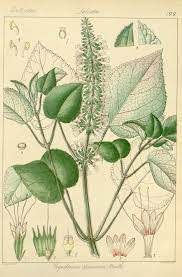Patchouli (Pogostemon patchouli or P. cablin) is a bushy herb which grows to a height of one metre and has soft, hairy, oval-shaped leaves and spikes of white, purple-tinged flowers. When rubbed, the leaves emit the peculiar, charasmatic scent of patchouli. Native to Southeast Asia, the shrub grows in Sumatra and Java between altitudes of 900 - 1,800 metres.

It is now cultivated extensively for its oil in India, China, Malaysia and Indonesia.
The leaves and stems are harvested two or three times a year. Most of the plant material is distilled on site because patchouli shrubs are grown in remote areas - in small plots shaded by jungle trees. However, the jungle still are very primitive, usually consisting of a couple of metal drums, stacked on top of a couple of each other and supported by mud and bricks. One of the drums holds the plant material and one is used to boil the water by direct fire. The oil that is produced is dark reddish-brown, due to the presence of iron deposits (harmless to the skin) absorbed from the metal drums. Some connoisseurs of patchouli appreciate this colour and ask for it specifically.
A proportion of the patchouli crop is baled like silage and transported to the main cities where the leaves are distilled in modern, stainless steel tanks. The oil from this is pale yellow with a full-bodied aroma, and labelled 'patchouli light'. It's a little more expensive than the usual patchouli oil because of the additional labour and transportation costs. Patchouli light is usually obtainable only by mail order from specialist aromatherapy suppliers.
There is also a rectified patchouli oil - this is the 'jungle-grade' product which has been re-distilled to remove the iron deposits. The resulting oil is virtually colourless with a pleasing, earthy aroma. Although perfect for perfumery purposes, the rectified product loses many of the therapeutic components found in the original oil and is not used in aromatherapy.
The Strongest Scent

Patchouli is one of the few oils whose aroma improves with age. A young patchouli oil smells rather sour, like raw, damp jungle undergrowth, but as it matures the scent develops an earthy sweetness.
It is said to be the strongest aroma in the plant kingdom, and one of the longest lasting base notes used in perfumery. It lingers on clothes for many weeks, often even after laundering.
Patchouli began to be used in Europe in about 1826, as a result of the craze for paisley-patterned Indian shawls. Scottish and French manufacturers machine-made cheaper fakes but were frustrated by the fact that valuable Indian shawls could be identified by a particular odour which always clung to them. Eventually, they realised it was patchouli and they began to import the oil to perfume their imitations.
Wherever patchouli is grown, the dried crushed leaves are commonly used to scent linen and discourage insects. Hippies wore patchouli as a perfume in the 1960s and 1970s and burned it as incense, partly for its reputed aphrodisiac effects and partly because its penetrating odour masks that of marijuana. It is patchouli that helps give black Indian ink its colour.
Therapeutic Properties
For centuries patchouli has been used in traditional medicine in Malaysia, China and Japan. A word of warning though, the old herbal texts caution that over-use of patchouli causes loss of appetite, insomnia and nervousness.
Patchouli has been credited with antifungal, anti-inflammatory, antibacterial and astringent properties. Teas made of the leaves are said to help diarrhoea and fevers, and act as a restorative during convalescence. Applied externally, the cooled tea (or diluted oil) heals fungal infections of the skin.
These days patchouli is not a major remedy for physical ailments, although it is valuable for cracked and sore skin conditions, such as athlete's foot, as well as general skin and hair care, especially for oily skin and dandruff. Under the supervision of a qualified aromatherapist, it is also useful for impetigo, ringworm and weeping eczema.
Patchouli reigns supreme in the emotional sphere. It imparts an intriguing nuance to blends intended to help mild depression and nervous exhaustion. Its 'grounding' quality is often helpful for people who 'live in their heads' and are prone to over-thinking and worry.
Anecdotal evidence among aromatherapists suggests that low dilutions of the oil are relaxing and restorative; whereas higher concentrations may excite the nervous system. Yet very high concentrations used over a prolonged period may have the opposite effect, resulting in stupor. As always with essential oils, the precise mind/body effect cannot be predicted. Much depends on the state of the individual at a given time, and whether or not the aroma is perceived as pleasing. Some texts refer to patchouli as an aphrodisiac, but again this largely depends on whether you like the aroma.